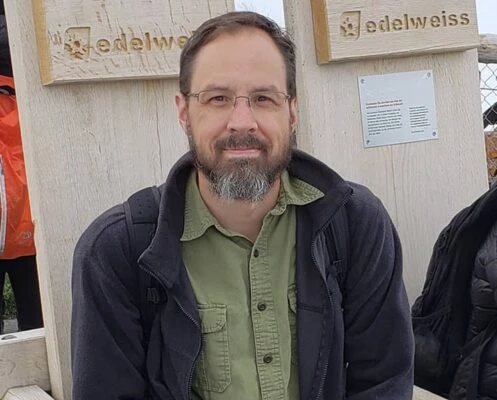
This month’s Apex Magazine cover artist is Adrian Borda, whose surreal and imaginative works offer a fascinating look at life. His work often explores heavy emotions through inanimate objects, giving life to the otherwise lifeless.
APEX MAGAZINE: Many of your pieces, including this month’s Apex Magazine cover, “Life is a Dance in The Rain III”, feature mechanical items performing human actions. What are the challenges of giving emotion and humanity to otherwise inanimate objects?
ADRIAN BORDA: The challenge is to arouse the viewer’s interest so he’ll project himself into the scene. I believe it is more interesting to make a projection into an inanimate object than into a living being.
AM: Your works seem to be influenced by many different styles of art, from classical renaissance works through modern surrealism. When you are creating your works, is that a subconscious idea to feature a similar style, or does it evolve as you work?
AB: The ideas come from my subconscious as raw images, like pieces of a puzzle, but I need to compose them in a coherent story that can be meaningful to the viewer. It can be a quick process, or can take months or even years until the final piece is put on canvas. It’s difficult to be original, to have no obvious influences from other styles. Painting is quite a mature art and artists have explored most of its corners in search of originality. But I do believe there is still a huge virgin ground that has been explored by very few with artistic talent, in the shamanic trance.
AM: Between your still life pieces and your more surreal works, are your techniques separate from one another, or do they work together overall? For example, does working on still life pieces influence your technique with a different, more surrealistic piece?
AB: No, the technique is quite similar in all my oil paintings, no matter the subject, the more conceptual are bigger chances to suffer modifications during work, as the idea may evolve until I finish it. Over the past couple of years I have become more and more passionate about photography, and I believe this is going to have a bigger and bigger impact on my paintings, because what photography can produce and joggle with images is much easier than with painting.
AM: Many of your character works, such as “I’m Here to Entertain You”, feature strong emotions such as fear and loss. Is art something you use as a catharsis to work out emotions, or is the canvas a separate world from your own?
AB: I try to express the entire spectrum of emotions through my work, but isn’t necessarily the catharsis of a past trauma. They can come out of empathy with other people, or even fictional characters.
AM: Musical instruments appear in your art frequently, in a number of forms. What do you find fascinating about the mix of art and music? Are there certain types of music that influence your work?
AB: I find music is a gate to deep emotional states, as well as the visual arts, and sometimes a visual stimulus can make us recall a song, or vice versa. And if the image arouses the curiosity and makes you wonder how it could sound, it would be even more memorable and have a profound impact.
I’m not influenced by any particular type of music, but I like the elegance of classic instruments. I have a few series of paintings that have a similar theme, because as I evolve I see newer and newer aspects that I’m tempted to give life to.









